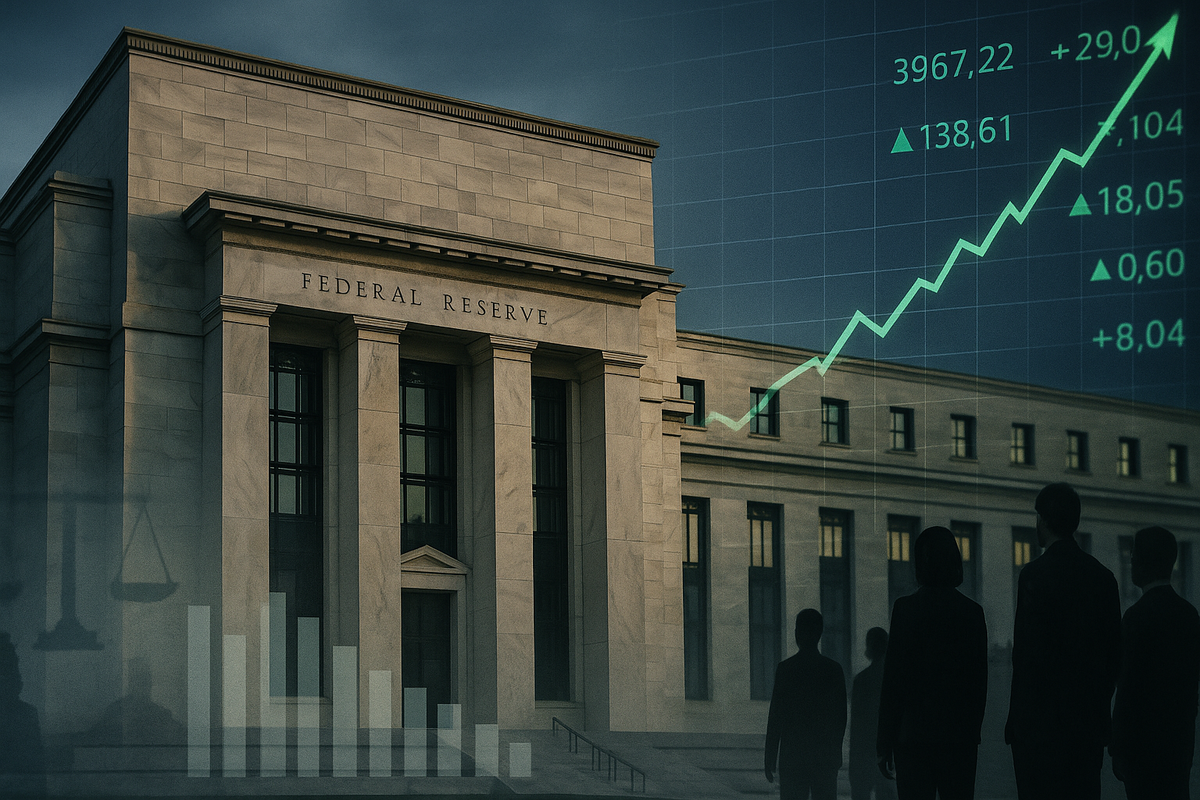
The Federal Reserve is on the cusp of a significant shift in its monetary policy, with strong indications pointing towards an interest rate cut in September 2025. This widely anticipated move, primarily influenced by a softening labor market and moderating inflation, has sent ripples through financial markets, igniting optimism among investors while also raising complex questions about the central bank's independence in a politically charged environment. The potential cut marks a pivotal moment, signaling the Fed's recalibration of its restrictive stance in response to evolving economic data, yet simultaneously underscoring heightened political pressures on the institution.
Powell's Pivot and the Weakening Labor Market
Federal Reserve Chair Jerome Powell's recent remarks at the Jackson Hole Economic Symposium have emerged as the primary catalyst for the heightened expectation of a September rate cut. On August 22, 2025, Powell stated that "with policy in restrictive territory," the "baseline outlook and the shifting balance of risks may warrant adjusting our policy stance." This statement was immediately interpreted by markets as a clear signal that the Fed is preparing to ease its monetary policy, marking a significant departure from its previous restrictive stance.
A key driver behind this pivot is the discernible weakening of the labor market. Powell explicitly highlighted increasing downside risks to employment, noting a "marked slowing in both the supply of and demand for workers." Recent data from 2025 supports this assessment, showing a considerable decline in monthly job creation, averaging a modest 35,000 over the past three months, a stark contrast to the 168,000 per month recorded in 2024. Concurrently, the unemployment rate has moderately risen to 4.2% in August. These indicators suggest that the Fed's aggressive rate hikes have had their intended effect of cooling the economy, making room for a policy adjustment.
Furthermore, while still slightly above the Federal Reserve's 2% target, inflation has shown signs of moderation, consistently hovering around the 3% range according to the Consumer Price Index (CPI) data. This stabilization provides the Fed with more flexibility to consider rate cuts without immediately reigniting inflationary pressures. The current federal funds rate target range of 4.25%-4.50% is considered restrictive, and an adjustment is seen as a necessary recalibration given the evolving economic landscape. Major financial institutions, including Goldman Sachs and Morgan Stanley, have revised their forecasts to anticipate a September rate cut, with market probabilities for a 25-basis-point reduction ranging from 82% to nearly 90%.
The initial reaction from financial markets was overwhelmingly positive. U.S. stock prices surged, with the Dow Jones Industrial Average (DJIA) reaching an all-time high, and the S&P 500 (SPX) and Nasdaq Composite (IXIC) also experiencing significant gains. U.S. Treasury yields declined, and gold prices rose as investors anticipated cheaper borrowing costs and a potentially weaker U.S. dollar. However, this initial euphoria was tempered with caution as the week progressed, with some experts questioning the pace of subsequent cuts beyond September, suggesting that while a September cut is largely priced in, the path forward remains uncertain.
Who Wins and Who Loses from a Rate Cut?
A Federal Reserve interest rate cut typically aims to stimulate economic activity by making borrowing cheaper, but its impact ripples unevenly across different sectors and companies. The prospect of a September rate cut creates distinct potential winners and losers in the stock market.
Potential Winners: Companies and sectors with high debt loads, those reliant on consumer spending, and those whose valuations are sensitive to discount rates are poised to benefit. The Consumer Discretionary sector is a prime beneficiary, as lower borrowing costs and increased disposable income for consumers can boost demand for non-essential goods and services. Companies like Nike (NYSE: NKE), Disney (NYSE: DIS), Netflix (NASDAQ: NFLX), Airbnb (NASDAQ: ABNB), and Tesla (NASDAQ: TSLA) could see enhanced sales and profitability. Major retailers such as Target (NYSE: TGT) and Walmart (NYSE: WMT) may also experience a lift.
The Real Estate and Home Construction sector stands to gain significantly from lower mortgage rates, which make homeownership more affordable and stimulate demand. Homebuilders and suppliers like Builders FirstSource (NASDAQ: BLDR) and Mohawk Industries (NYSE: MHK) are expected to thrive. Online real estate platforms like Opendoor Technologies (NASDAQ: OPEN) could see increased transaction volumes. Technology companies, often relying on debt for research and development and expansion, will find capital cheaper. While large tech giants like Alphabet (NASDAQ: GOOGL), Apple (NASDAQ: AAPL), Microsoft (NASDAQ: MSFT), and NVIDIA (NASDAQ: NVDA) benefit from improved valuations, mid-cap and startup tech firms with higher debt-to-equity ratios, such as Etsy (NASDAQ: ETSY) and Carvana (NYSE: CVNA), could see more pronounced improvements in their financial health. Utilities (e.g., NextEra Energy (NYSE: NEE), Duke Energy (NYSE: DUK)) and Industrials (e.g., Caterpillar (NYSE: CAT)) are also likely to benefit from reduced borrowing costs for their capital-intensive projects and increased economic activity. Small-cap companies, generally more sensitive to interest rate fluctuations due to higher debt, could experience a greater positive impact.
Potential Losers: Conversely, the Financial Institutions sector, particularly banks, may face headwinds. While lower rates can stimulate loan demand, they typically compress net interest margins (the difference between interest earned on loans and interest paid on deposits), directly impacting profitability for institutions like JPMorgan Chase (NYSE: JPM) and Bank of America (NYSE: BAC). Regional banks such as First Horizon National Corp. (NYSE: FHN) are also vulnerable to margin compression. However, some investment banks like Goldman Sachs (NYSE: GS) might benefit from increased capital markets activity spurred by cheaper borrowing for mergers, acquisitions, and debt issuance. The Insurance sector can also be adversely affected as lower rates reduce returns on their investment portfolios and the present value of future cash flows. Companies with significant cash reserves or revenue models tied to prevailing interest rates may also see reduced interest income. It's also worth noting that while often beneficiaries, some sectors like utilities and real estate could face negative pressure if long-term bond yields unexpectedly rise, making their dividend or rental income less attractive compared to higher-yielding bonds.
Industry Impact and Broader Implications Amidst Independence Concerns
A Federal Reserve interest rate cut extends its influence far beyond individual stock performances, weaving into the fabric of broader economic trends, industry dynamics, and potentially challenging the very independence of the central bank. The decision to cut rates, while aimed at stimulating growth, carries complex implications for inflation, global markets, and regulatory landscapes, all while navigating an increasingly politicized environment.
The relationship with inflation is particularly nuanced. Historically, inflation tends to fall during rate-cutting cycles as an economic slowdown often precedes such cuts, but it can pick up about a year after the final cut. While recent data shows inflation moderating to around 3%, it remains above the Fed's 2% target. Compounding this, presidential decisions, such as the imposition of tariffs, have been observed to exert upward pressure on inflation, complicating the Fed's efforts to manage price stability. Geopolitical events, including ongoing conflicts and trade tensions, also introduce global supply chain and energy price uncertainties that influence the Fed's policy choices.
Globally, a U.S. rate cut is expected to foster a more accommodative monetary environment. Lower interest rates in the world's largest economy encourage business funding and consumer spending, which can support struggling industries worldwide. Nations with substantial debt denominated in U.S. dollars stand to benefit from reduced interest payments, freeing up crucial budget space. This move could also signal a downward trajectory for global interest rates, prompting other central banks to consider their own easing policies. However, these nations must remain vigilant against potential volatility in capital flows that could impact their currencies and economic stability.
Within the U.S., various industries will experience significant ripple effects. The banking industry is likely to see increased activity, with major U.S. banks lowering prime rates to remain competitive. This reduces interest rates on various loans, improving borrower cash flow and potentially reducing loan loss reserves, which in turn stimulates lending and deal flow. Wholesale and syndicated lending markets are expected to surge, and non-investment grade issuers may find it easier to access high-yield debt capital. The real estate market will be directly impacted, as lower federal funds rates generally translate to reduced mortgage interest rates. This makes homeownership more accessible, encourages refinancing, and stimulates demand, potentially leading to increased home prices and activity in the multifamily and commercial real estate sectors. The manufacturing sector stands to benefit as well, with cheaper borrowing costs facilitating capital investments in equipment and IT, thereby stimulating consumer spending and increasing demand across the supply chain. However, some experts caution that the full benefits to manufacturing might not be immediately apparent until 2025 due to existing high inventory levels.
From a regulatory standpoint, a Fed rate cut, as a tool of expansionary monetary policy, influences various interest rates throughout the economy. This necessitates businesses to review and adhere to updated compliance requirements, loan documentation standards, and financial reporting obligations. Policymakers must continually assess the risks of market shifts and inflation expectations while seizing opportunities for economic growth. Historically, the U.S. has experienced numerous rate-cutting cycles, often coinciding with slowing economic growth. When cuts occurred during "soft patches" rather than severe recessions, stock markets typically rallied, and consumer spending generally increased.
Crucially, recent actions have significantly heightened concerns regarding the Federal Reserve's independence. A survey of economists revealed that over three-quarters are worried about political interference compromising the Fed's autonomy. The current presidential administration has taken a notably confrontational approach, publicly pressing the Fed to cut interest rates and even suggesting a desire to remove the current Fed Chair, Jerome Powell. The most notable recent event fueling these concerns is the administration's unprecedented attempt to fire Fed Governor Lisa Cook over unproven allegations. This move is seen as a direct challenge to the central bank's autonomy, as governors serve 14-year terms, a safeguard designed to ensure monetary policy decisions are based on data and long-term economic interests, removable only "for cause." Governor Cook has stated her intention to sue the administration over this attempted removal. Economists warn that eroding trust in the central bank's autonomy threatens the dollar's role as the world's reserve currency and the U.S.'s ability to service its national debt. It risks making monetary policy decisions less credible and less efficient, potentially hindering the Fed's ability to effectively fight inflation. This ongoing battle is seen as a critical test of the Fed's ability to maintain its independence in the face of political pressure.
What Comes Next
The anticipated September interest rate cut by the Federal Reserve sets the stage for a period of both opportunities and challenges, shaping the short-term and long-term economic landscape. Businesses, investors, and policymakers alike will need to adapt to the evolving environment, carefully considering potential strategic pivots and preparing for various outcomes.
In the short-term, a rate cut is expected to stimulate economic activity. Lower borrowing costs will encourage consumer spending on large purchases like homes and cars, and incentivize businesses to invest and expand. This should lead to improved borrowing conditions, further job creation, and a boost in GDP. However, there's an acknowledgment that a rate cut, particularly if the economy is more resilient than expected or due to ongoing tariff impacts, could lead to a temporary uptick in inflation. For businesses, this means potential cost savings on existing loans and cheaper financing for new projects, making expansion, capital expenditures, and even mergers and acquisitions more attractive. Investors may see a rally in rate-sensitive sectors, especially small-cap companies, and potentially a weaker U.S. dollar benefiting emerging markets and commodities.
Long-term, the Fed's ultimate goal remains price stability (2% inflation) and maximum employment. Morningstar projects additional rate cuts through 2027, bringing the federal funds rate to a target range of 2.25%-2.50% by 2028, with the 10-year Treasury yield also sliding to 3.25% by that time. The primary long-term risk remains a resurgence of inflation if cuts are premature or underlying demand is robust. However, inflation is largely anticipated to moderate in 2027 as economic growth softens. Strategic pivots for businesses will involve leveraging lower borrowing costs to refinance debt, invest in innovation (especially AI-driven technologies), and capitalize on increased M&A activity. Investors should consider extending the duration of bond holdings, diversifying into rate-sensitive equities, and exploring precious metals as a hedge.
However, challenges persist. The most significant is the risk that premature rate cuts could reignite inflation, forcing the Fed into a difficult reversal and potentially eroding its credibility. Prolonged periods of low-interest rates could also inflate asset bubbles across various classes, leading to future financial instability. The financial sector, particularly banks with significant net interest income exposure, might face margin compression. Housing affordability could remain a challenge despite lower mortgage rates due to elevated home prices. Moreover, the ongoing political interference and concerns about the Fed's independence create a layer of uncertainty and potential market volatility.
Two primary scenarios loom. Scenario 1: The Federal Reserve cuts rates in September as anticipated. This outcome suggests the Fed believes current economic conditions warrant easing. We would likely see a boost in consumer spending, business investment, and job creation, but with a lingering risk of inflation ticking up. Stock markets would likely rally, bond prices would increase, and the U.S. dollar could weaken. Scenario 2: The Federal Reserve rate cut is delayed. This would signal ongoing concerns about inflation or underlying economic strength. Higher borrowing costs would persist, potentially restraining capital-intensive industries and hindering expansion. While inflation might moderate more gradually, there's a risk of a slowdown in the labor market. Investors might see increased market volatility, and the "higher for longer" narrative would continue to dominate. The risk of "stagflation" (high inflation with weak growth) could also become a greater concern. The Fed's policy decisions will remain highly data-dependent, requiring close attention to inflation metrics, employment figures, and global economic developments.
A Crucial Juncture for the U.S. Economy
The Federal Reserve's anticipated September interest rate cut marks a crucial juncture for the U.S. economy, signaling a shift from a restrictive monetary policy stance to one aimed at fostering growth amidst a softening labor market and moderating inflation. The decision, primarily driven by Federal Reserve Chair Jerome Powell's dovish signals and evolving economic data, promises to reshape the financial landscape, offering both significant opportunities and notable risks across various sectors.
The key takeaway for investors and businesses is the expected easing of borrowing costs, which will likely stimulate consumer spending and corporate investment. Sectors such as consumer discretionary, real estate, home construction, technology, utilities, and industrials are poised to benefit from cheaper capital and increased demand. Conversely, financial institutions, particularly traditional banks, may face challenges due to compressed net interest margins. However, the broader implications extend beyond market performance, touching on the delicate balance of inflation management and the integrity of the global economy.
Moving forward, investors should keenly watch for continued signs of labor market softening and the trajectory of inflation, as these will be critical in determining the pace and number of any subsequent rate cuts. The potential for a weaker U.S. dollar, often a consequence of rate cuts, could also create opportunities in emerging markets and for commodity prices. However, the shadow of political interference and concerns over the Federal Reserve's independence looms large. Recent presidential actions challenging the Fed's autonomy could undermine market confidence and introduce an unwelcome layer of political risk to monetary policy decisions.
Ultimately, the coming months will test the Fed's ability to navigate a complex economic environment while safeguarding its institutional independence. Businesses should strategically consider debt refinancing, capital investments, and potential M&A activities, while investors should prioritize diversified portfolios with an eye on rate-sensitive sectors and inflation hedges. The decisions made by the Federal Reserve in late 2025 will not only dictate the immediate economic trajectory but also leave a lasting impact on investor confidence, market stability, and the perceived autonomy of one of the world's most influential central banks.



